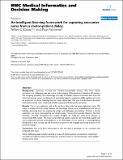An Intelligent Listening Framework for Capturing Encounter Notes from a Doctor-Patient Dialog
Author(s)
Klann, Jeffrey G.; Szolovits, Peter
Download1472-6947-9-S1-S3.pdf (346.9Kb)
PUBLISHER_CC
Publisher with Creative Commons License
Creative Commons Attribution
Terms of use
Metadata
Show full item recordAbstract
Background: Capturing accurate and machine-interpretable primary data from clinical encounters is a challenging task, yet critical to the integrity of the practice of medicine. We explore the intriguing possibility that technology can help accurately capture structured data from the clinical encounter using a combination of automated speech recognition (ASR) systems and tools for extraction of clinical meaning from narrative medical text. Our goal is to produce a displayed evolving encounter note, visible and editable (using speech) during the encounter. Results: This is very ambitious, and so far we have taken only the most preliminary steps. We report a simple proof-of-concept system and the design of the more comprehensive one we are building, discussing both the engineering design and challenges encountered. Without a formal evaluation, we were encouraged by our initial results. The proof-of-concept, despite a few false positives, correctly recognized the proper category of single-and multi-word phrases in uncorrected ASR output. The more comprehensive system captures and transcribes speech and stores alternative phrase interpretations in an XML-based format used by a text-engineering framework. It does not yet use the framework to perform the language processing present in the proof-of-concept. Conclusion: The work here encouraged us that the goal is reachable, so we conclude with proposed next steps. Some challenging steps include acquiring a corpus of doctor-patient conversations, exploring a workable microphone setup, performing user interface research, and developing a multi-speaker version of our tools.
Date issued
2009-11Department
Massachusetts Institute of Technology. Computer Science and Artificial Intelligence Laboratory; Massachusetts Institute of Technology. Department of Electrical Engineering and Computer ScienceJournal
BMC Medical Informatics and Decision Making
Publisher
BioMed Central Ltd
Citation
BMC Medical Informatics and Decision Making. 2009 Nov 03;9(Suppl 1):S3
Version: Final published version
ISSN
1472-6947